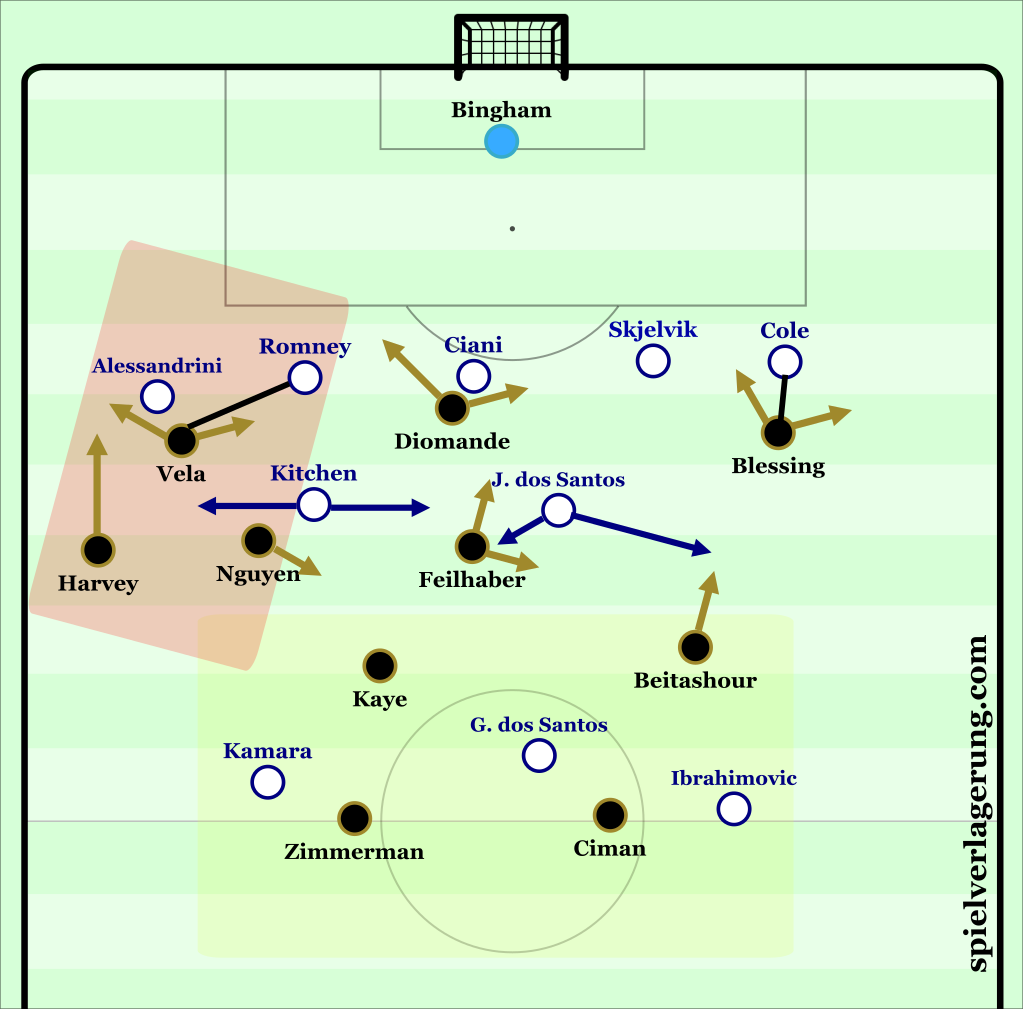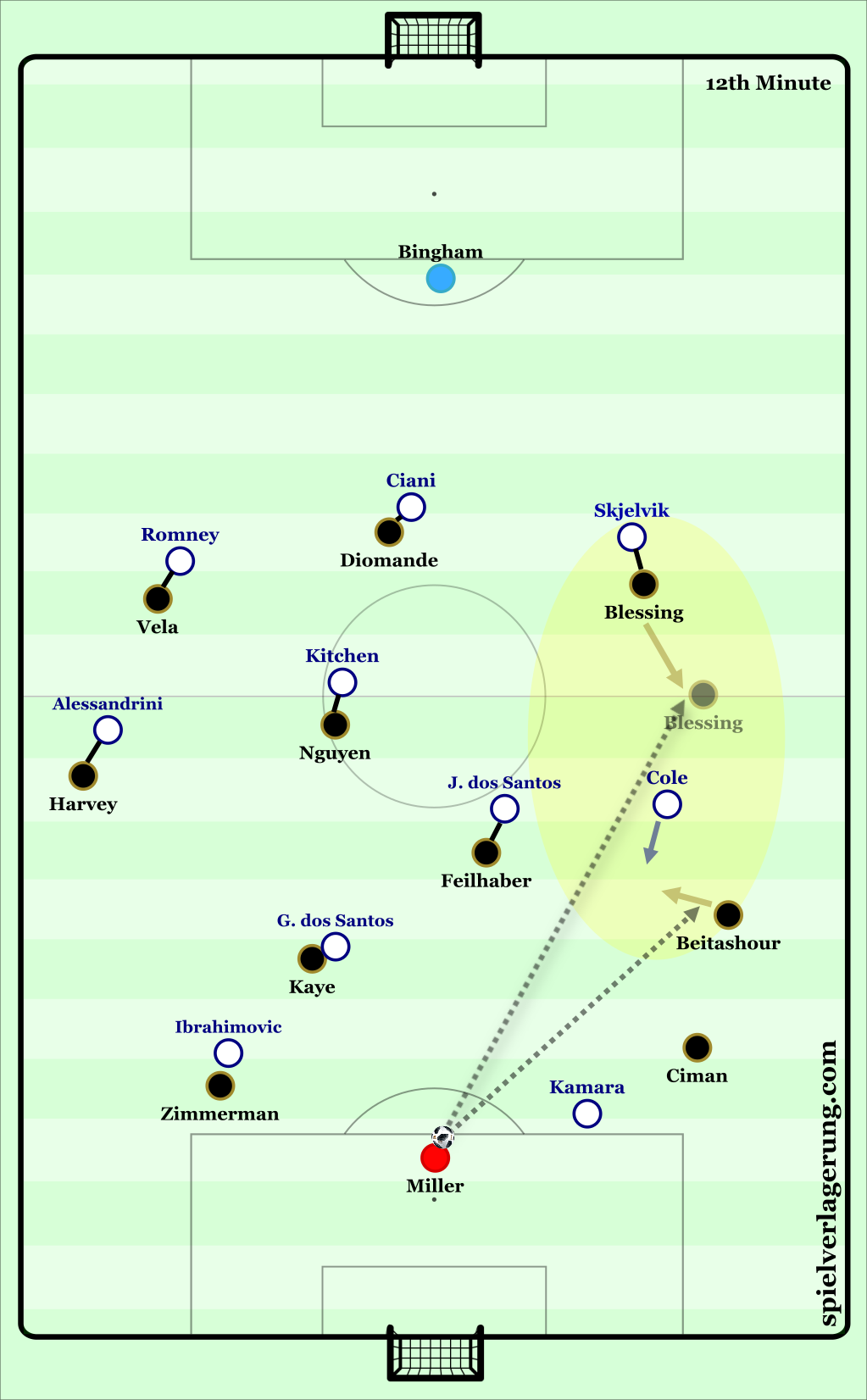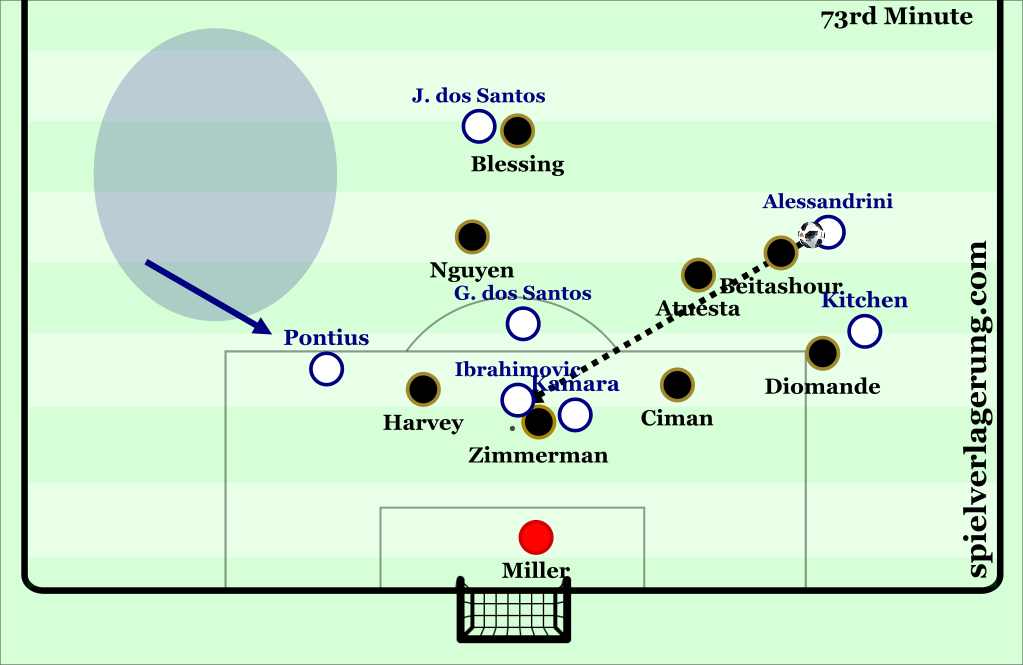LAFC squander lead vs LA Galaxy
While most clubs are preparing for their upcoming seasons throughout the summer, a handful are in the heart of their domestic seasons. The bright lights of Los Angeles staged LAFC hosting their crosstown nemesis LA Galaxy for the first time in their new stadium. With the first meeting between the sides gaining attention because of Zlatan’s debut performance and the Galaxy’s inspired comeback, the sequel saw LAFC relinquish their early advantage once again in a dramatic and puzzling manner.
Since the arrival of Ibrahimovic, the Galaxy have shifted their base structures to accommodate him alongside the other attacking talents in their team. Mainly organized in a 3-4-1-2, Romain Alessandrini and Ashley Cole comprise of the the right and left wingbacks respectively. Perry Kitchen and Jonathan dos Santos occupy the midfield spots just ahead of the defensive line, with Kitchen holding more often as his partner will move higher in the course of possession. Brother Giovanni slots in at the 10, with Ola Kamara and Zlatan taking the two advanced forward roles.
LAFC’s 4-3-3 was conventional. Vela and Blessing worked as wingers, with Lee Nguyen and Benny Feilhaber being their primary sources of passes. Diomonde was the main target man for chance creation, during which Beitashour and Harvey ventured forward from the defensive line. Mark-Anthony Kaye started as the link between the defensive line and attackers for build up and ball recoveries, but left early in the first due to injury. The Canadian was replaced by Eduard Atuesta.
LAFC Wide Focus defeats man-orientations
The opening minutes of the match forecasted the trajectory for most of the match, particularly regarding the areas of tactical emphasis for both teams. The Galaxy opted to implement a deeper block in their defensive structure, gladly organizing about twenty five metres from their goal. Manager Sigi Schmidt subjected his team to higher degrees of risk in this respect as they ceded a lot of constructive territory for LAFC to develop attacks, with the attacking trio remaining in high positions for counter attacking outlets compounding this spatial gamble. With Cole and Alessandrini joining the centre backs, the structure against the ball for the Galaxy was a 5-2-0-1-2.
This neglecting of deeper midfield afforded LAFC to register more higher potential attacks early on. These were commonly direct thus bypassing the middle. The midfield would be involved in possession regains, second ball recovery, or circulation to open up more spaces for the wingers. With Feilhaber sliding centrally, a leftward shift was apparent in initial attacking developments. Kaye’s starting position was tilted toward the left halfspace, with Nguyen being just ahead of him.
Vela, the star man in attack, starting position on this side showed his side’s intent to have him be a considerable source of both forward progression and chance creation, with his strong dribbling abilities being a fundamental part of Bob Bradley’s strategy. With Alessandrini’s conversion to wingback being relatively new and his prior history as a more attacking minded player, LAFC aimed to target that side to take advantage of subsequent structural issues that came from mistimed steps to pressure and weaker individual defending.
In addition, LAFC’s priorities in attack were to get the ball toward these wide areas because of the numerical advantages on the wings that came with the Galaxy’s defensive structure. With Vela and Blessing functioning as direct dribbling wingers, the fullbacks on their side moved in support to create 2vs1 overloads in wide spots. On occasion, the sidebacks, Romney and Skjelvik, for the Galaxy would slide over in support, creating a large horizontal distance between the defensive line. Thus, Diomonde would have greater area to be able to dismark Ciani and get on the end of targeted passes and crosses from either the wingers or fullbacks, with the winger tucking inside as an additional option if the fullback joins higher into the attacking third.

LAFC’s leftward attack versus the Galaxy’s defense, which not only outnumbered them in wide areas, but also placed high demands on Kitchen and J. Dos Santos to deal with side to side circulation.
The sequence which ended in LAFC’s first goal originated in this aspect, with Diomonde able to keep in Harvey’s inital cross because of an absence of defensive wing support for Cole, who was mainly concerned with Blessing because of the Galaxy’s man orientations. This LAFC wing focus was so prominent that connections within the nearest halfspaces would sometimes be absent as LAFC looked to create chances, aiming to get combinations down the wings to cross, but fail to have consistent angles to bait LA Galaxy’s pressures to create higher potential dynamics. With an increase in attacks coming down the right from minutes 20-25, Vela was switched with Blessing at minute 30, aiming to improve the chances of another goal sourced from that flank. Laurent Ciman also began to be more adventurous with his dribbling out of the back, drawing the Galaxy out from their men to apply pressure toward the ball and free up passing options on the right side.
In terms of handling this development defensively, the central duo defensively for the Galaxy was unable to effective support toward the wing unless their player went toward the wing, while the front three were distant from these efforts, sparingly pressuring out of individual concern rather than collectivist methods of winning the ball. Over time, this led to prolonged periods close to their goal, as LAFC were able to regain possession easily because of favorable outcomes in individual duels amongst the centre backs and a well organized rest defense with Kaye/Atuesta in front alongside Beitashour to screen passes into the galactic threesome.
When the ball was with Miller, Galaxy’s lines moved up for man coverage, marked tight to their player. Avoiding the risk of conceding with their lead, LAFC played long passes to evade the press in these situations. Yet these were the only situations where the man-orientations had the desired outcome for the Galaxy, as close to goal, LAFC’s player movements were intelligent to dismark Galaxy defenders, initiating movements as fixation shifted from them toward the ball, and moving diagonally between players to get on the end of through passes.

Galaxy’s man-orientations in defense when Miller is in possession – with a couple of possible solutions to break the pressure rather than just playing long toward Vela.
A mixture of these man-orientations and LAFC committing more numbers forward as the Galaxy left players high proved a bad omen for the visiting club, since it invited their opponents to easily progress up the pitch through simple side to side circulation. If the wingers couldn’t comfortably dribble by their player, they could just cycle it toward the other wing and start over, with little pressure being applied in central areas during this process. It was this pattern that established LAFC as the more capable of the two clubs in the match in the first half, adequately reflected in their two goal lead. Yet it wasn’t entirely dominant, as it was reliant on individual ability and some degree of improvisation, as opposed to clearly defined attacking patterns and combinations.
Galaxy unable to exploit LAFC compactness issues
As prolific as LAFC were out of the gates, the Galaxy were equally as toothless in their attacking play. Due to a mixture of their starting positions when recovering possession and distribution choices, the Galaxy were subjected to faulty situations each time they won the ball back, resigned to playing long passes up to Kamara and Ibrahimovic, each of them isolated from any support for knockdowns or second balls.
Of course not every attack originated in the depths near their own goal, so the Galaxy were able to register some circulation, albeit it was mainly as a precursor to an eventual long ball. With the wingbacks slightly higher, the Galaxy hoped to occupy the opposition fullback and have him subsequently step toward him. In turn, the Galaxy to then hit linear long balls from defense into these channels for the forwards to run onto, or Giovanni dos Santos starting from central areas. The subsequent support from the wingbacks or midfielders would provide service into the penalty area if the forward could not.
Consequently, attacking possessions for the Galaxy were short in duration, as long balls have a high probability of being picked out or cleared, alongside crosses having a low success rate for chance creation. This consistent pattern of losing possession right after winning it elongated the team structure from both an attacking and defending viewpoint.
Despite starting out as more of a midfield press, this ended up shifting the dynamics of LAFC’s pressure during the match. Sensing the favorable outcomes and the potential of a third goal, the forward and midfield lines more frequently stepped out of their positions to get pressure to the ball. Multiple reasons could go into this, as they could either: want to force Galaxy to play balls earlier, potentially compromising the execution quality; win the ball from the defensive line who is not proficient in build up; or force them to play backwards. Yet the LAFC back line was concerned with the incoming long ball, thus creating sizable separation between the lines of play.
Similar to his performances with Mexico in the run-up to the World Cup (that he didn’t feature in), Giovanni’s tendency to remain higher up the pitch restricted his team’s ability to break down their opponents. Rather than hold his position and make smaller adjusting movements as the opponent shifts in response to the ball, dos Santos would run ahead of Ibrahimovic in pursuit of these long balls. Thus, the 3-4-1-2 was commonly a 3-4-0-3, with a lack of presence in the ten space severely limiting the quality and number of connections the Galaxy were able to make in possession, coercing them into play long balls into the channels.

Rather than position himself in the vacant central areas, Giovanni elects to run in behind to receive a long ball over the defense, eliminating the possibility of linking his team from front to back in attack to secure a better possession.
The Galaxy’s first half saw them enter with few genuine attempts on goal, with Ciman and Zimmerman’s tight marking being effective against the Scandinavian striker partnership, mainly restricting them to long, speculative efforts derived from individualism. A missing midfield presence in higher lines beneath for the attackers to orbit around severely hampered what the Galaxy could accomplish, leading to suboptimal chance creation and construction for the visitors.
Moving Pieces to the Front
The start of the second half for the Galaxy demonstrated an increase of numbers in higher lines of the pitch throughout multiple phases of play, representing more risk seeking in attack and defense. This comes perhaps at the cost of having fragmentation between the top and bottom of the team, continuing the expansion of space and time on the ball for both teams during the match.
Two readily noticeable changes occurred. First, rather than stand touch-tight to their man, the Galaxy dropped off slightly when Tyler Miller was in possession, prompting LAFC to build up their attacks through their centre backs. Afterwards they would apply pressure and restrict the wings, forcing LAFC to either dribble out of the pressure or play through the central players tightly marked and distant from the ball. Some flash of promise emerged from the high pressing for the Galaxy, but LAFC moved on from playing out of the back and opted for problem aversion instead of problem solving.
The second change took place regarding the positioning of the Galaxy’s wingbacks, now occupying a starting position 15 metres higher than in the first half, with less defensive responsibility on getting back into the defensive line in favor of more counterpressure when losing possession. With the introduction of Chris Pontius for Ashley Cole, Schmidt began to move more numbers forward in the hopes of something coming from it. Alessandrini moved to the left side, allowing him to cut inside and provide more of a distal shooting threat, while Pontius offered a hybrid role between winger and striker that is somewhat reminiscent of Georgios Samaras’ tenure at Celtic.
The method of distribution from the back to the front of the team was largely unchanged. Ibrahimovic periodically dropped deeper to function as the forward distributor that makes him so unique at times, but the Galaxy continued their direct approach. The main difference was that LAFC had to allocate attention to more frequent attacks and more players involved with them, eroding the defensive lines over the course of the match. This gradually tipped the scales for the Galaxy, as crosses were bombarded into the box with three or four players into the penalty area, including the far side wing back moving inward to provide another possible player to get on the end of these services.

When the Galaxy moved more players forward, Pontius vacated his wide starting spot in the final third to enter the penalty area in hopes of getting on the end of crosses like this one from Alessandrini.
Just after Sebastian Lletget came into the match, the Galaxy got the breakthrough goal via Alessandrini, sourced from a long ball knocked into the right channel spaces in between centre back and fullback targeted in the first half. This prompted more sitting back from LAFC as the Galaxy pushed their players even farther forward with more directness. Tyler Miller made a handful of great saves to keep them in the driver’s seat. However, substitute Andre Horta, making his LAFC debut, gifted his opponents the equalizer, passing the ball back into a gray area between Ciman and Miller that Ola Kamara was perfectly positioned to receive before rounding the keeper and scoring. The last minutes were frantic as both sides chased for a winner, but they ended up splitting the points.
Conclusion
In the league table, the margin of four points between the two sides is maintained. LAFC supporters will be crushed that that gap was not increased, yet another meeting next month will provide an additional opportunity to get a derby win. Both sides expressed some common themes, mainly the reliance on a series of individuals for chance creation. LAFC in particular has resources in their team that could be used to create a very good team in possession, which will be interesting to watch develop as they approach their playoff competition. If more patience was exhibited in possession alongside a more central focus in their possession, LAFC would be one of the more dominant teams in the league.



Keine Kommentare vorhanden Alle anzeigen